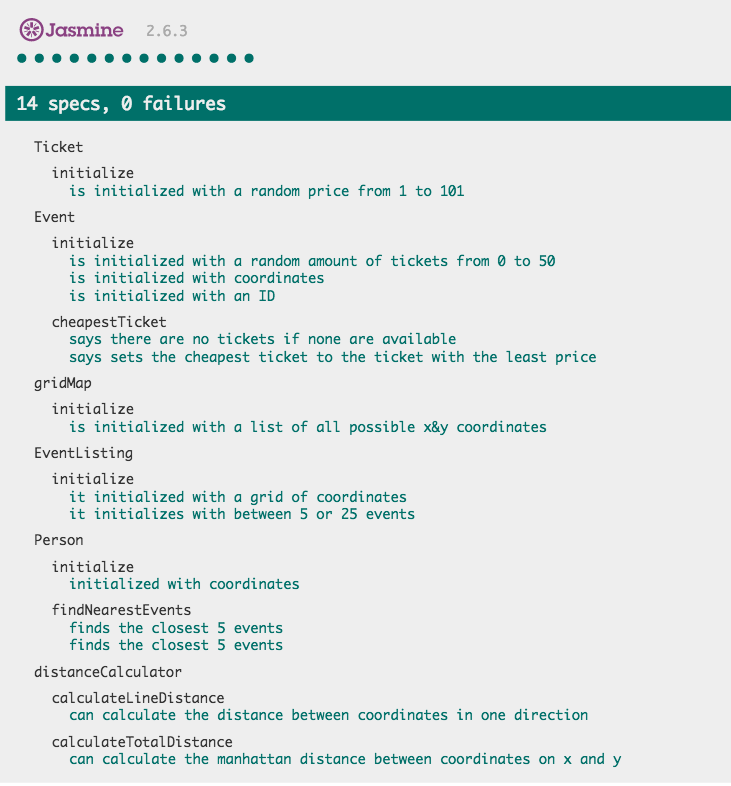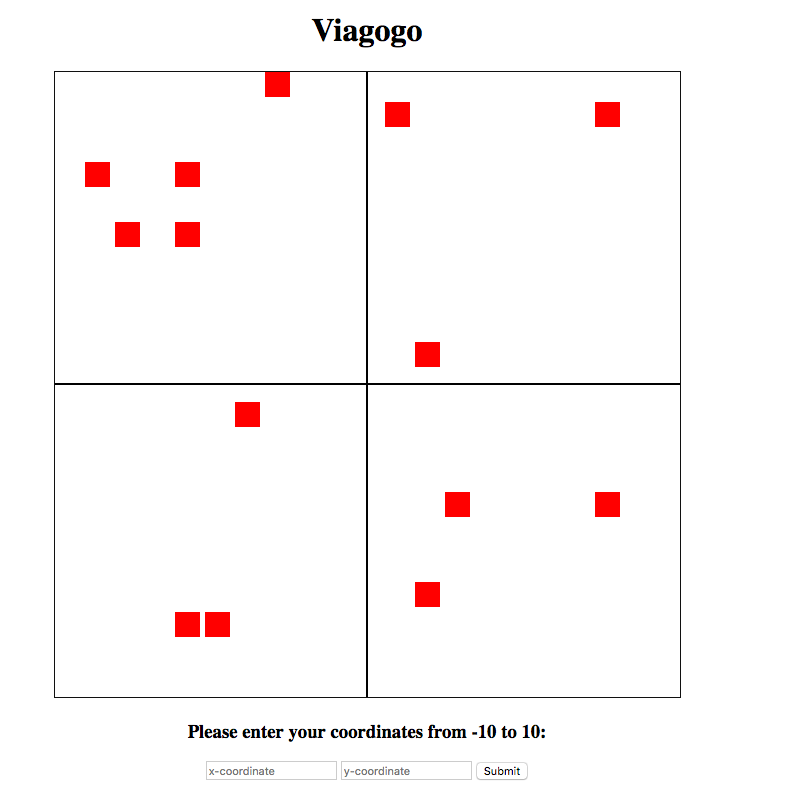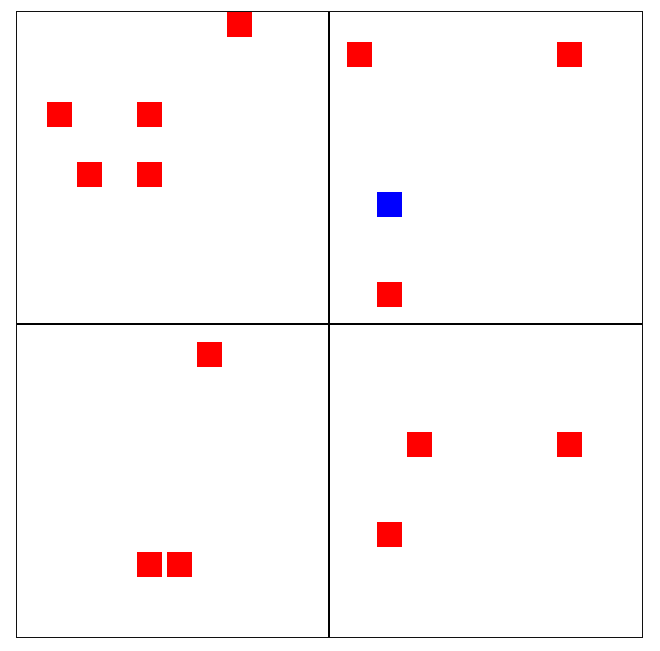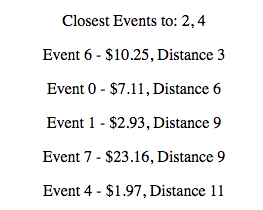• Your program should randomly generate seed data.
• Your program should operate in a world that ranges from -10 to +10 (Y axis), and -10 to +10 (X axis).
• Your program should assume that each co-ordinate can hold a maximum of one event.
• Each event has a unique numeric identifier (e.g. 1, 2, 3).
• Each event has zero or more tickets.
• Each ticket has a non-zero price, expressed in US Dollars.
• The distance between two points should be computed as the Manhattan distance.
You are required to write a program which accepts a user location as a pair of co- ordinates, and returns a list of the five closest events, along with the cheapest ticket price for each event.
I originally intended for this to be a purely back-end project, which I was going to write in javascript and running it in node. But as I progressed with it, I decided it would be much easier to visualise with a simple front-end aspect too.
I began with the back-end and broke down the program to its simplest constituent parts. I have constructor functions for the following:
The Ticket : This has a randomly generated price from 1.00 to 101.00.
The Event : This is generated with a random amount of tickets, coordinates, and a unique ID. It also has the ability to find out which is its cheapest ticket.
The GridMap : This is a map of coordinates. It is given the parameters of the grid, and calculates ever possible integer coordinate available within it.
The EventListing : This is constructed with a GridMap that sets the limitations of the world. It then generates a random amount of events within this world. When an event is created, those coordinates are removed from the GridMap making it unavailable for other randomly generated events.
The DistanceCalculator : This calculates the Manhattan distance of a two coordinates. It first calculates the distance of a line, so from x to x, and then calculates from y to y.
The Person : This is constructed with an EventListing, coordinates and a DistanceCalculator. With knowledge of its own coordinates and all the events' coordinates, it can then calculate the closest five events.
The FrontEnd : This is a visualisation of the backend. When the document loads, an EventListing is displayed. All the events in the listing are shown on a grid. The user then has an ability to input coordinates which generates a Person. These coordinates are also displayed on the grid and underneath it shows the information of the closest five events and their cheapest ticket.
Clone this repository and then enter the root directory by typing the following into the terminal:
git clone git@github.com:jackbittiner/Viagogogogogo.git
cd Viagogogogogo
This program was test-driven. To see the tests in all their passing glory enter the following command in the command line:
open SpecRunner.html
and you should see the following:
Enter the following command in the command line:
open viagogo.html
and you should see a grid of randomly positioned events, and two input fields for you to put down your coordinates like so:
Input your desired coordinates and click submit. You should see a new blue square on the grid that represents your coordinate like so:
Also the nearest five events appear under the grid, showing the unique event ID, the cheapest ticket price, and the distance from the user:
Javascript: Although I'm probably better at showing good, clean coding practices in Ruby, I wanted to showcase my abilities in Javascript because it is a more common, more universal language and I do enjoy writing in it.
Jasmine: For the testing.
HTML: For the visualisation of the back-end.
JQuery: For a dynamic front-end that handles the event of user input.
Q) How might you change your program if you needed to support multiple events at the same location?
A) When events are randomly generated, the coordinates picked are removed from the freeVenues property. However if I wanted to add a new event at the same location, it is still possible to create a new event with the same coordinates as another event. The method would look something like this:
EventListing.prototype.addEvent(coordinates) = function() {
var ID = this.listings.length;
this.listings.push(new Event(coordinates, ID));
}
Q) How would you change your program if you were working with a much larger world size?
A) It is very simple to change the size of the world I'm working with. I have a constructor called gridmap that decides the size of the world, and creates all the possible coordinates in the world. If you pass it larger numbers as parameters, then a larger world will be created.
I feel I might have spread myself a little thin on this tech testing as I decided to do both front and back-end. If I had more time these are the further things that I would work on.
User Input: There is nothing stopping the user from putting in a a non-numeric value in the input fields. There is also no restrictions from them putting in a number that is larger than the confounds of the grid. To address this I would raise errors on the backend if the user's coordinates surpassed the coordinates of the grid. Then I would probably stop it in the front by having the user select a coordinate from a list rather than inputting a value.
Adding More Events: The code fulfils the purpose of the test. It generates random event data. But it would be nice to add more events if needed.
Design: I tend to always focus on the backend of a project first, and then make it look pretty afterwards. If I had more time I would design the page more and give it some pizzazz that it desperately needs.
Price: If there are no tickets for an event, the price on the front-end is displayed as '$undefined'. I would implement a simple if else statement here that would display "There are no tickets for this event" if there were no tickets.
Thank you for taking the time to look over this test! There is still a bit more work that needs to be done on it, but I hope it showcases my ability to think logically and work well with code!



